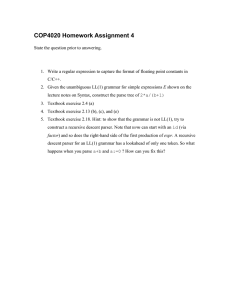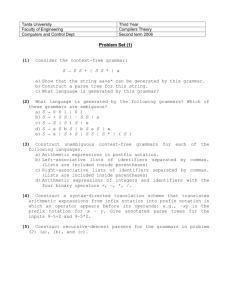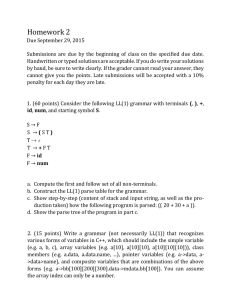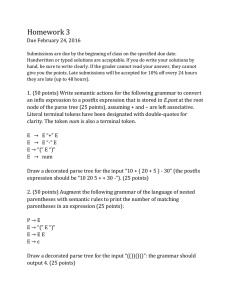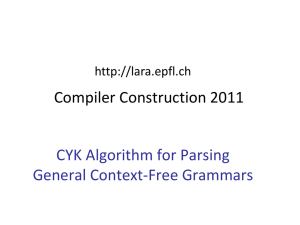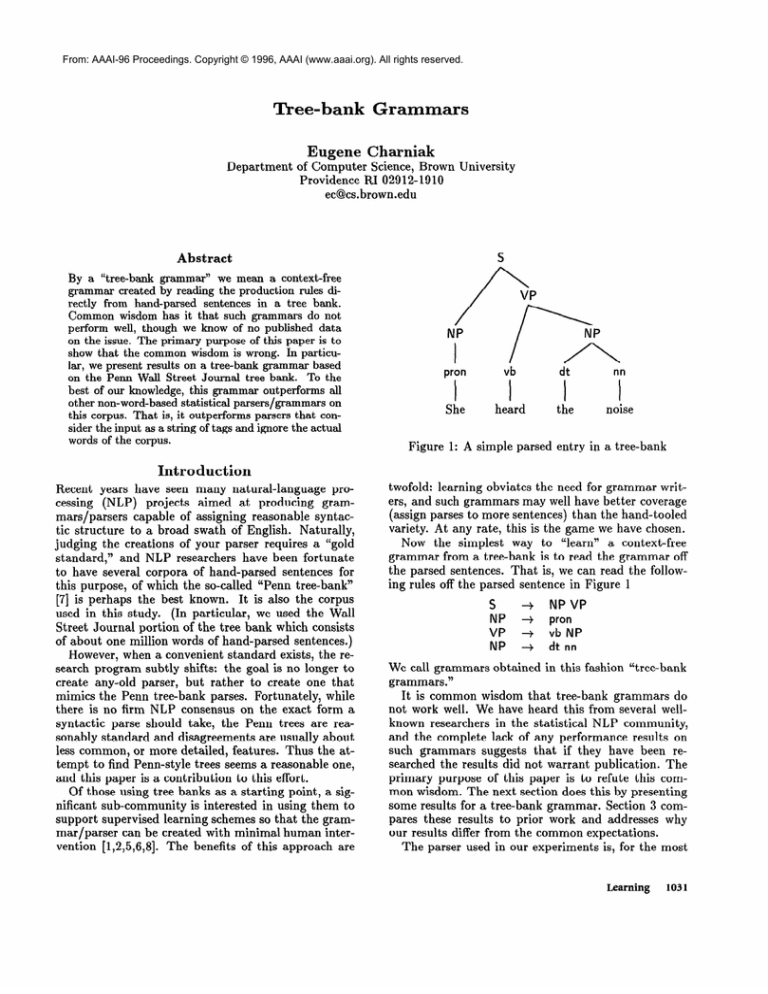
From: AAAI-96 Proceedings. Copyright © 1996, AAAI (www.aaai.org). All rights reserved.
Tree-bank Grammars
Eugene
Charniak
Department of Computer Science, Brown University
Providence RI 02912-1910
ec@cs.brown.edu
Abstract
By a “tree-bank grammar” we mean a context-free
grammar created by reading the production rules directly from hand-parsed sentences in a tree bank.
Common wisdom has it that such grammars do not
perform we& though we know of no published data
on the issue. The primary purpose of this paper is to
show that the common wisdom is wrong. In particular, we present results on a tree-bank grammar based
on the Penn WaII Street Journal tree bank. To the
best of our knowledge, this grammar outperforms ah
other non-word-based statistical parsers/grammars on
this corpus. That is, it outperforms parsers that consider the input as a string of tags and ignore the actual
words of the corpus.
P
VP
NP
NP
/
pron
vb
dt
nn
She
heard
the
noise
Figure 1: A simple parsed entry in a tree-bank
Introduction
Recent years have seen many natural-language processing (NLP) projects aimed at producing grammars/parsers capable of assigning reasonable syntactic structure to a broad swath of English. Naturally,
judging the creations of your parser requires a “gold
standard,” and NLP researchers have been fortunate
to have several corpora of hand-parsed sentences for
this purpose, of which the so-called “Penn tree-bank”
[7] is perhaps the best known. It is also the corpus
used in this study. (In particular, we used the Wall
Street Journal portion of the tree bank which consists
of about one million words of hand-parsed sentences.)
However, when a convenient standard exists, the research program subtly shifts: the goal is no longer to
create any-old parser, but rather to create one that
mimics the Penn tree-bank parses. Fortunately, while
there is no firm NLP consensus on the exact form a
syntactic parse should take, the Penn trees are reasonably standard and disagreements are usually about
less common, or more detailed, features. Thus the attempt to find Penn-style trees seems a reasonable one,
and this paper is a contribution to this effort.
Of those using tree banks as a starting point, a significant sub-community is interested in using them to
support supervised learning schemes so that the grammar/parser can be created with minimal human intervention [1,2,5,6,8]. The benefits of this approach are
twofold: learning obviates the need for grammar writers, and such grammars may well have better coverage
(assign parses to more sentences) than the hand-tooled
variety. At any rate, this is the’game we have chosen.
Now the simplest way to “learn” a context-free
grammar from a tree-bank is to read the grammar off
the parsed sentences. That is, we can read the following rules off the parsed sentence in Figure 1
S
NP
VP
NP
+
+
+
+
NPVP
pron
vb NP
dt nn
We call grammars obtained in this fashion “tree-bank
grammars.”
It is common wisdom that tree-bank grammars do
not work well. We have heard this from-several wellknown researchers in the statistical NLP community,. ,
and the complete lack of any performance results on
such grammars suggests that -if they have been researched the results did not warrant publication. The
primary purpose of this paper is to refute this common wisdom. The next section does this by presenting
some results for a tree-bank grammar. Section 3 compares these results to prior work and addresses why
our results differ from the common expectations.
The parser used in our experiments is, for the most
Learning
1031
part, a standard chart parser. It does differ from the
standard, however, in two ways. One is an efficiency
matter - we improved its ability to search for the
most probable parse. This is discussed briefly in section 3 as well. The second difference is more unusual.
On impressionistic evidence, we have come to believe
that standard PCFGs do not match English’s preference for right-branching structures. In section 4 we
present some ideas on how this might be corrected and
show how these ideas contribute to the performance
results of section 2.
The Experiment
We used as our tree bank the Penn parsed Wall Street
Journal corpus, release 2. ’ We divided the sentences
into two separate corpora, about 100,000 words for
testing and about l,OOO,OOO
words for training. We ignored all sentences in the testing data of length greater
than 40 because of processing-time considerations; at
any rate, the actual number of such sentences is quite
low, as the overall average sentence length is about 22
words and punctuation. Of the 100,000 words of testing data, half were used for preliminary testing and the
other half for “official” testing - the results reported
here.
With the exception of the right-bracketing bias discussed later, the training was particularly simple. We
obtained a context-free grammar (CFG) by reading the
rules off all the sentences in the training data. Trace elements indicated in the parse were ignored. To create a
probabilistic CFG, a PCFG, we assigned a probability
to each rule by observing how often it was used in the
training corpus. Let 1 T ] be the number of times rule
T occurred in the parsed training corpus and X(T) be
the non-terminal that ir expands. Then the probability
assigned to r is
Pm
=
b-1
Cr’E(r’1x(T’)=x(T)}I r’ I
(1)
After training we test our parser/grammar on the
test data. The input to the tester is the parsed sentence
with each word assigned its (presumably) correct part
of speech (or tag). Naturally the parse is ignored by the
parser and only used to judge the parsers output. Also,
our grammar does not use lexical information, but only
the tags. Thus the actual words of the sentence are
irrelevant as far as our parser is concerned; it only
notices the tag sequence specified by the tree-bank.
For example, the sentence in Figure 1 would be “pron
vb dt nn."
We used as our set of non-terminals those specified
in the tree-bank documentation, which is roughly the
‘An earlier draft of this paper was based upon a preliminary version of this corpus. As this earlier version was
about one-third the size and somewhat less “clean,” this
version of the paper sports (a) a larger tree-bank grammar
(because of more training sentences), and (b) somewhat
better results (primarily because of the cleaner test data).
1032
Natural Language
Sentence
Lengths
2-12
2-16
2-20
2-25
2-30
2-40
Average
Length
8.0
11.5
13.9
16.3
18.8
22.0
Precision
91.5
89.6
87.3
85.5
83.6
82.0
Recall
89.1
87.1
84.9
83.3
81.6
80.0
Accuracy
96.9
95.0
92.9
91.2
89.7
88.0
Figure 2: Parsing results for the tree-bank grammar
set specified in [7]. It was necessary to add a new start
symbol, Sl, as all the parses in our version of the tree
bank have the following form:
((S (NP The dog) (VP chewed (NP the bone)) .))
Note the topmost unlabeled bracketing with the single
S subconstituent, but no label of its own. We handled
such cases by labeling this bracket Sl.’
We use the full set of Penn-tree-bank terminal parts
of speech augmented by two new parts of speech, the
auxiliary verb categories aux and auxg (an aux in the
“ing” form). We introduced these by assigning all occurrences of the most common aux-verbs (e.g., have,
had, is, am, are, etc.) to their respective categories.
The grammar obtained had 15953 rules of which only
6785 occurred more than once. We used all the rules,
though we give some results in which only a subset are
used.
We obtained the most probable parse of each sentence using the standard extension of the HMM Viterbi
algorithm to PCFGs. We call this parse the map (maximum a posteriori) parse. We then compared the map
parse to the one given in the tree-bank testing data.
We measured performance by three observations:
1. precision: the percentage of all non-terminal bracketings appearing in map parses that also appear as
a non-terminal bracketing in the corresponding treebank parse,
2. recall: the percentage of all non-empty non-terminal
bracketings from the tree bank that also appeared as
non-terminal bracketings in the map parse, and
3. accuracy: the percentage of all bracketings from the
map parses that do not cross over the bracketings in
the tree-bank parse.
The results obtained are shown in Figure 2.
At about sixteen thousand rules, our grammar is
rather large. We also ran some tests using only the
20ne interesting question is whether this outermost
bracketing should be counted when evaluating the precision and recall of the grammar against the tree-bank. We
have not counted it in this paper. Note that this bracketing
always encompasses the entire sentence, so it is impossible
to get wrong. Including it would improve our results by
about l%, i.e., precision would increase from the current
82% to about 83%.
Sentence
Lengths
2-16
Grammar
Size
Full
Reduced
2-25
2-40
Precision
89.6
89.3
Recall
87.1
Accuracy
95.0
87.2
94.9
Full
Reduced
85.5
85.1
83.3
83.3
91.2
91.1
Full
Reduced
82.0
81.6
80.0
80.0
88.0
87.8
Figure 3: Parsing results for a reduced tree-bank grammar
A- The tree-bank grammar
@ - The PCFG of [5]
17 - The transformational
parser of [a]
0 - The PCFG of [B]
lOO-
A
0
95-
A
qn
3. the probabilities are correct, but the tag sequence
by itself does not provide sufficient information to
select the correct parse,
A
0
A
A
85-
Figure 4: Accuracy
several parsers
:5
VS.
4. the information is sufficient, but because the parser
could not consider all of the possible parses, it did
not find the correct parse,
5. it found the correct parse, but the the tree-bank
“gold standard” was wrong (or the correct parse is
simply not clear).
0
0
110
1. the necessary rules are not in the grammar,
2. the rules are there, but the probabilities are incorrect,
A
90-
age sentence length increases - i.e., when longer sentences are allowed into the testing corpus, The only
data point that matches our current results is one for
an earlier grammars of ours [5], and that only for very
short sentences.
This is not to say, however, that there are no betMagerman [6] reports preciter grammars/parsers.
sion and accuracy figures of 86% for WSJ sentences of
length 40 and less. The difference is that Magerman’s
parser uses statistics based upon the actual words of
the sentence, while ours and the others shown in Figure 4 use only the tags of the words. We believe this
shows the importance of including lexical information,
a point to which we return below.
Next we turn to the discrepancy between our results
and the prevailing expectations.
Roughly speaking,
one can identify five reasons why a parser does not
identify the “correct” parse for a sentence:
40
average sentence length for
subset of rules that occurred more than once. As noted
earlier, this reduced the number of rules in the grammar to 6785. Interestingly, this reduction had almost
no impact on the parsing results. Figure 3 gives first
the results for the full grammar followed by the results
with the 6785-rule subset; the differences are small.
Discussion
To put the experimental results into perspective it is
useful to compare them to previous results on Wall
Street Journal data. Figure 4 compares the accuracy
figures for our tree-bank grammar with those of three
earlier grammars/parsers that also used Wall Street
Journal text for testing purposes. We compare only
accuracy figures because the earlier work did not give
precision and recall figures.
It seems clear that the tree-bank grammar is more
accurate than the others, particularly when the aver-
Of these, (3) and (5) are important but not relevant
to the current discussion. Of the rest, we believe that
(1) is a major component of the low expectations for
tree-bank grammars. Certainly it was our major concern. Penn-style trees tend to be be rather shallow, and
the 40-odd parts of speech allow many possible combinations. For example, consider the NP “the $200 to
$400 price range”, which has the tag sequence dt $ cd
to $ cd nn nn. Our tree-bank grammar does not have
the corresponding NP rule (or any reasonable combination of rules as far as we can tell) and thus could
not assign a correct parse to a sentence that contained
this N P. For this reason we gave some thought to how
new rules might be introduced and assigned non-zero
probability. Indeed, we started on this work becuase
we believed we had a interesting way to do this. In
the event, however, no such complications proved necessary. First, our grammar was able to parse all of the
test sentences. Second, it is not too hard to show that
coverage is not a first-order problem.
In retrospect, our concerns about coverage were not
well thought out because of a second property of our
tree-bank grammar, its extreme overgeneration.
In
particular, the following fact is true:
Let x be the set of the tree-bank parts of speech
minus the following parts of speech: forward and
Learning
1033
Sentence
Lengths
2-16
Data
Used
Testing
Training
Precision
89.6
90.7
Recall
87.1
88.6
Accuracy
95.0
95.4
2-25
Testing
Training
85.5
86.7
83.3
84.0
91.2
91.6
2-40
Testing
Training
82.0
83.7
80.0
81.1
88.0
88.6
Figure 5: Parsing results for the tree-bank grammar
backward single quote mark (neither of which occurred in our corpus) 9 sym (symbol), uh (interjection), o (final punctuation), and ). Any string in
x* (where “*” is the normal Kleene star operator)
is a legitimate prefix to a sentence in the language
of our tree-bank-grammar, and furthermore, any
non-terminal may start immediately following x*.
In other words, our grammar effectively rules out no
strings at all, and every possible part of speech can
start at almost any point in the sentence. The proof
of this fact is by induction on the length of the string
and is straightforward but tedious3
Of course, that our grammar comes up with some
parse for a sentence does not mean that it is immune
to missing rules. However, we can show that possible missing rules are not a first-order problem for our
grammar by applying it to sentences from the training
corpus. This gives an upper bound on the performance
we can expect when we have all of the necessary rules
(and the correct probabilities). The results are given
in Figure 5. Looking at the data for all sentences of
length less than or equal to 40, we see that having all
of the necessary rules makes little difference.
We noted earlier that the tree-bank grammar not
only overgenerates, but also places almost no constraints on what part of speech may occur at any point
in the sentence. This fact suggests a second reason for
the bad reputation of such grammars - they can be
hard on parsers. We noticed this when, in preliminary
testing on the training corpus9 a significant number of
sentences were not parsed - this despite the fact that
our standard parser used a simple best-first mechanism. That is, the parser chooses the next constituent
to work on by picking the one with the highest “figure
of merit.” In our case this is the geometric mean of
the inside probability of the constituent.
Fortunately, we have been also working on improved
best-first chart parsing and were able to use some new
3So tedious that after proving this fact for the tree-bank
grammar used in the fkst draft of this paper, we could not
muster the enthusiasm necessary to confirm it for the current grammar. However, since the new grammar is larger
than that in the earlier draft, the above theorem or a similar one will surely hold.
1034
Natural Language
techniques on our tree-bank grammar. We achieved
the performance indicated in Figure 2 using the following figure of merit for a constituent Nj,k , that is,
a constituent headed by the ith non-terminal, which
covers the terms (parts of speech) tj . . . tk- 1
P($,k
P(Ni
I to,n)sa
I tj-l)P@j,k
I WP@k
I N”) (2)
&j,k+d
Here p(tj,k+l) is the probability of the sequence of
terms tj . . .tk and is estimated by a tri-tag model,
p(i!j,k ] N”) is the inside probability of Nj,k and is
computed in the normal.fashion (see, e.g., [4] ), and
p(N’ ] Q-r) and p(i!k I NZ) are estimated by gathering
statistics from the training corpus.
It is not our purpose here to discuss the advantages of this particular figure of merit (but see [3]).
Rather, we simply want to note the difficulty of obtaining parses, not to mention high-probability parses,
in the face of extreme ambiguity. It is possible that
some of the negative “common wisdom” about treebank grammars stems from this source.
Right-branching
Bias
Earlier we noted that we made one modification to
our grammar/parser other than the purely efficiencyrelated ones discussed in the last section. This modification arose from our long standing belief that our
context-free parsers seemed, at least from our nonsystematic observations, to tend more toward centerembedding constructions than is warranted in English. It is generally recognized that English is a rightbranching language. For example, consider the following right-branching bracketing of the sentence “The cat
licked several pans.”
( (The (cat (licked (several pans)))) .)
While the bracketing starting with “cat” is quite absurd, note how many of the bracketings are correct. This tendency has been exploited by Brill’s [2]
“transformational parser,” which starts with the rightbranching analysis of the sentence and then tries to
improve on it.
On the other hand, context-free grammars have
no preference for right-branching structures. Indeed,
those familiar with the theory of computation will recognize that the language anbn, the canonical center
embedded language, is also the canonical context-free
language. It seemed to us that a tree-bank grammar,
because of the close connection between the “goldstandard” correct parses and the grammar itself, offered an opportunity to test this hypothesis.
As a starting point in our analysis, note that a rightbranching parse of a sentence has all of the closing
parentheses just prior to the final punctuation. We call
constituents that end just prior to the final punctuation “ending constituents” and the rest “middle constituents.” We suspect that our grammar has a smaller
propensity to create ending constituents than is warranted by correct parses. If this is the case, we want
to bias our probabilities to create more ending constituents and fewer middle ones.
The “unbiased” probabilities are those assigned by
the normal PCFG rules for assigning probabilities:
P(4
=
PWW
CET
Here 7r is a parse of the tag sequence, c is a nonterminal constituent of this parse, and rule(c) is the
grammar rule used to expand this constituent in the
parse. Assume that our unbiased parser makes 2 percent of the constituents ending constituents whereas
the correct parses have 9 percent, and that conversely
it makes u-percent of ihe constituents middle constituents whereas the correct parse has v percent.
We hypothesized that y > z-and u > v. Furthermore
it seems reasonable to bias the probabilities to account
for the underproduction of ending constituents by dividing out by 2 to get an “uninfluenced” version and
then multiplying by-the correct probability y to make
the influence match the reality (and similarly for middle constituents). This gives the‘following equation for
the probability of a parse:
Y/X
if c is ending
otherwise
(4)
CET
Note that the deviation of this equation from the standard context-free case is heuristic in nature: it derives
not from any underlying principles, but rather from
our intuition. The best way to understand it is simply
to note that if the grammar tends to underestimate the
number of ending constituents and overestimate middle constituents,the above equation will multiply the
former by g/x, a number greater than one, and the
latter by-VI& a number less than one.
Furthermore, if we assume that on the average the
total number of constituents is the same in both the
map parse and the tree-bank parse (a pretty good assumption), and that y and u (the numbers for the correct -parses) are collected from the training data, we
need collect only one further number, which we have
chosen as the ending factor E = y/x.
To test our theory, we estimated s from some heldout data. It came out 1.2 (thus confirming, at least
for this test sample, our hypothesis that the map
parses would underestimate the number of ending constituents). We modified our parse probability equation
to correspond to Equation 4. The data we reported
earlier is the result. Not using this bias yields the “Unbiased” data shown here:
Precision
Recall
Accuracy
88.0
With bias
82.0
80.0
77.3
85.4
Unbiased
79.6
2.7
2.6
Difference
2.4
P(4
=
v/u
The data is for sentences of lengths 2-40. The differences are not huge, but they are significant - both in
the statistical sense and in the sense that they make
up a large portion of the improvement over the other
grammars in Figure 4. Furthermore, the modification
required to the parsing algorithm is trivial (a few lines
of code), so the improvement is nearly free.
It is also interesting to speculate whether such a bias
would work for grammars other than tree-bank grammars. On the one hand, the arguments that lead one
to suspect a problem with context-free grammars are
not peculiar to tree-bank grammars. On the other,
mechanisms like counting the percentage of ending constituents assume that the parser’s grammar and that
of the gold standard are quite similar, as otherwise
one is comparing incomparables. Some experimentation might be warranted.
Conclusion
We have presented evidence that tree-bank grammars
perform much better than one might at first expect
and, in fact, seem to outperform other non-word-based
We then suggested two possible
grammars/parsers.
reasons for the mistaken impression of tree-bank grammars9 inadequacies. The first of these is the fear that
missing grammar rules will prove fatal. Here we observed that our grammar was able to parse all of our
test data, and by reparsing the training data have
showed that the real limits of the parsers’ performance
must lie elsewhere (probably in the lack of information provided by the tags alone). The second possible reason behind the mistaken current wisdom is
the high level of ambiguity of Penn tree-bank grammars. The ambiguity makes it hard to obtain a parse
because the number of possible partial constituents is
so high, and similarly makes it hard to find the best
parse even should one parse be found. Here we simply pointed to some work we have done on best-first
parsing and suggested that this may have tamed this
particular problem. Last, we discussed a modification
to the probabilities of the parses to encourage more
right-branching structures and showed how this led to
a small but significant improvement in our results. We
also noted that the improvement came at essentially
no cost in program complexity.
However, because of the informational poverty of tag
sequences, we recognize that context-free parsing based
only upon tags is not sufficient for high precision, recall, and accuracy. It seems clear to us that we need
to include lexical items in the information mix upon
which we base our statistics. Certainly the 86% precision and recall achieved by Magerman [6] supports
this contention. On the other hand, [6] abjures grammars altogether, preferring a more complicated (or at
least, more unusual) mechanism that, in effect, makes
up the rules as it goes along. We would suggest that
the present work, with its accuracy and recall of about
Sl%, indicates that the new grammatical mechanism
is not the important thing in those results. That is to
say, we estimate that introducing word-based statisLearning
1035
tics on top of our tree-bank grammar should be able
to make up the 5% gap. Showing this is the next step
of our research.
Acknowledgements
This research was supported in part by NSF grant IRI9319516.
References
1. BOD, R. Using au annotated language corpus as
a virtual stochastic grammar. In Proceedings of the
Eleventh National Conference on Artificial In telligence. AAAI Press/MIT Press, Menlo Park, 1993,
778-783.
2. BRILL, E. Automatic grammar induction and
parsing free text : a transformation- based approach.
In Proceedings of the 31st Annual Meeting of the
Association for Computational Linguistics. 1993,
259-265.
3. CARABALLO, S. AND CHARNIAK, E. Figures of
merit for best-first probabilistic chart parsing. Department of Computer Science, Brown University,
Technical Report , forthcoming .
E. Statistical
Language
4. CHARNIAK,
MIT Press, Cambridge, 1993.
Learning.
5. CHARNIAK, E. Parsing with context-free grammars and word statistics. Department of Computer
Science, Brown University, Technical Report CS-9528, 1995.
6, MAGERMAN,
D. M. Statistical decision-tree models for parsing. In Proceedings of the 33rd Annual
Meeting of the Association for Computational Linguistics. 1995, 276-283.
SANTORINI,
B.
M.
P.,
7. MARCUS,
AND MARCINKIEWICZ, M. A. Building a large annotated corpus of English: the Penn treebank. Computational Linguistics 19 (1993), 313-330.
8. PEREIRA, F. AND SCHABES, Y. Inside-outside
bracketed corpora. In
reestimation
from partially
27th Annual Meeting of the Association for Computaitonal Linguistics. ACL, 1992, 128-135.
1036
Naturd Language

